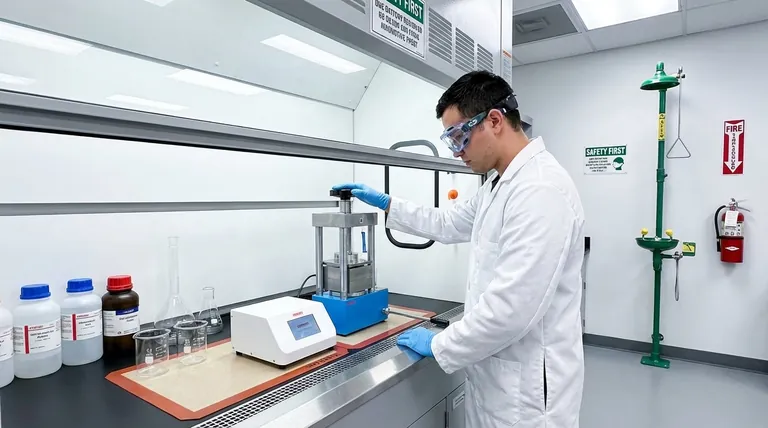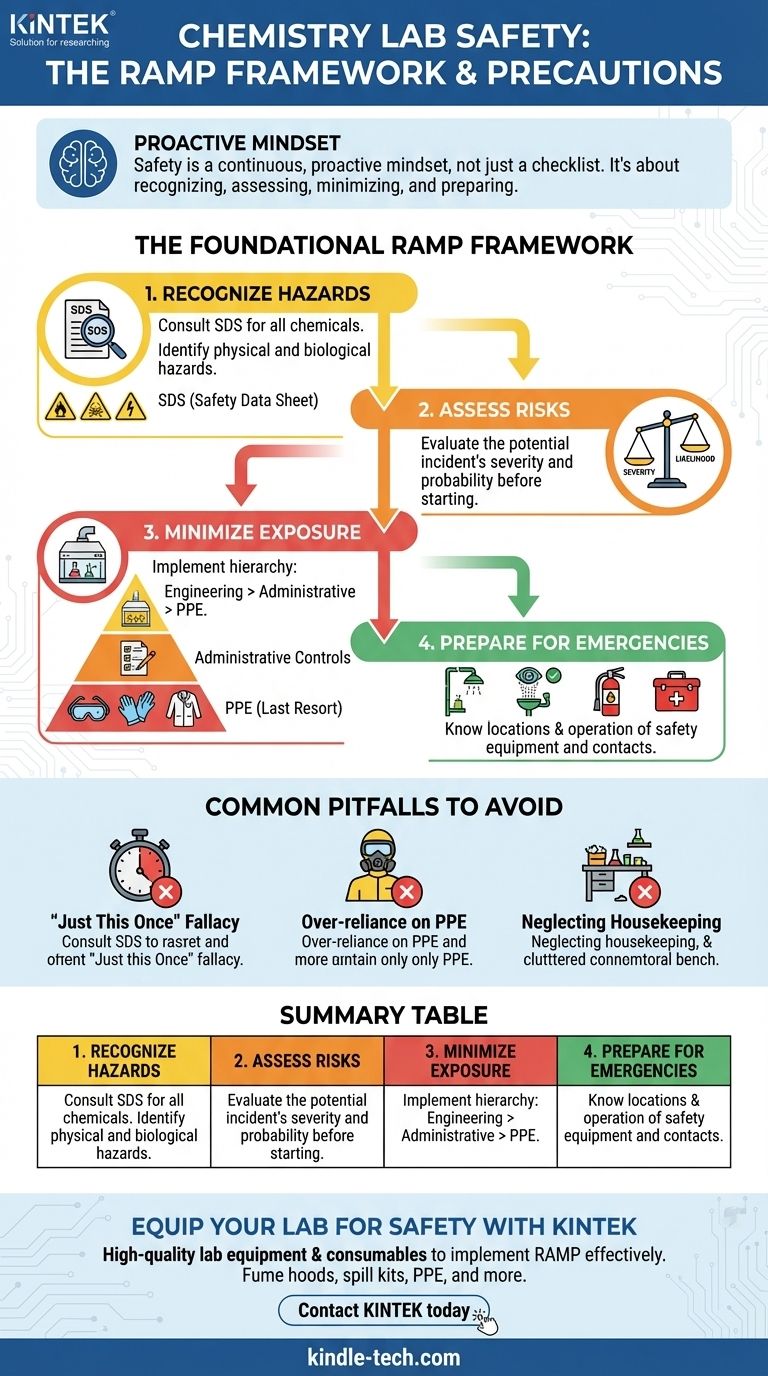化学実験室で最も重要な予防措置は、関わる物質とプロセスに対する基本的な尊重を中心としています。最低限、これには常に適切な個人用保護具(PPE)を着用すること、使用するすべての化学物質の特定の危険性を扱う前に理解すること、そしてすべての緊急安全装置の正確な場所と操作方法を知ることが含まれます。決して一人で作業せず、常に清潔で整理された作業スペースを維持して事故を防いでください。
真の実験室の安全とは、暗記すべき規則のチェックリストではなく、継続的で積極的な考え方です。それは、実験が始まる前から、ハザードの認識、リスクの評価、ばく露の最小化、緊急事態への備えというフレームワークの上に成り立っています。

基礎となるフレームワーク:RAMP
強固な安全文化は、実験室でのあらゆる作業に取り組むためのシンプルかつ強力なフレームワークであるRAMPの原則に基づいて構築されています。
ハザード(危険源)を認識する (Recognize the Hazards)
作業を開始する前に、潜在的な危害の原因を特定する必要があります。ハザードは必ずしも明白ではありません。
すべての化学物質には、関連する安全データシート(SDS)(以前はMSDSとして知られていました)があります。この文書は、引火性、毒性、反応性、および必要な安全対策に関する情報の主要な情報源です。
化学物質だけでなく、高圧システム、極端な温度、電気機器などの物理的ハザードも考慮してください。該当する場合、生物学的ハザードも独自の特定のプロトコルを必要とします。
リスクを評価する (Assess the Risks)
ハザードを認識することが第一歩であり、次はそのリスクを評価することです。リスクとは、潜在的なインシデントの重大性と、それが起こる可能性の組み合わせです。
自問してください:最悪のシナリオは何ですか?この実験はどのように失敗する可能性がありますか?軽度の刺激物の少量と、腐食性が高い、または爆発性の物質の大量では、リスクは全く異なります。
この評価が、手順に実施する必要がある管理措置のレベルを決定します。
ハザードを最小限に抑える (Minimize the Hazards)
これは安全の積極的な部分であり、リスクを低減するための管理措置を実施することです。これは明確な階層に従って行われます。
最も効果的な方法は、ハザードを取り除く物理的な設備である工学的管理(engineering controls)を使用することです。最も重要な例は、有毒または揮発性の蒸気を使用者から換気するドラフトチャンバー(化学ヒュームフード)です。
次に、従う手順とプロトコルである管理的管理(administrative controls)が続きます。これには、すべての容器の適切なラベリング、決して一人で作業しないこと、実験のための標準作業手順書(SOP)を作成することが含まれます。
最後の防衛線が個人用保護具(PPE)です。これには、飛沫防止化学ゴーグル、難燃性の白衣、適切な耐薬品性手袋、つま先の覆われた靴が含まれます。PPEはインシデントを防ぐものではありませんが、発生した場合にあなたを怪我から守ることができます。
緊急事態に備える (Prepare for Emergencies)
最善の計画があっても、事故は起こり得ます。準備は交渉の余地がありません。
安全シャワー、洗眼器、消火器、および流出物処理キット(スピルキット)の正確な場所と適切な使用方法を知っている必要があります。緊急時には一秒を争うため、指示を探している時間はありません。
緊急連絡先が明確に掲示されていること、そしてどれほど些細に見えてもインシデントを報告するための実験室の特定の処置を理解していることを確認してください。
一般的な落とし穴と誤解
安全プロトコルへの順守は、自己満足や実際の危険がどこにあるかについての誤解によって損なわれる可能性があります。これらの一般的な罠を避けることは、規則に従うことと同じくらい重要です。
「今回だけ」の誤謬 (The "Just This Once" Fallacy)
実験室での事故の大多数は、エキゾチックでハイリスクな手順によって引き起こされるわけではありません。それらは、日常的な作業からのわずかな逸脱、つまり「ちょっとした」移し替えのためにゴーグルを省略したり、「少量」の化学物質のためにドラフトチャンバーの使用を怠ったりすることによって引き起こされます。
この逸脱の正常化は、安全な実験室文化に対する最大の脅威です。基本的な安全対策を省略しても良いほど速い作業など存在しません。
PPEへの過度の依存
多くの人はPPEを安全のための主要なツールと見なしています。これは間違いです。PPEは最後の防衛線であり、他のすべての管理措置が失敗した場合にあなたを保護することを意図しています。
飛沫から保護するために手袋に頼ることは、そもそも飛沫が発生しないように手順を実施することよりもはるかに効果が低いです。常にPPEよりも工学的管理と管理的管理を優先してください。
整理整頓の無視
散らかった実験台、ラベルのない容器、塞がれた非常口は、不必要で完全に回避可能なハザードを生み出します。清潔で整理された実験室は、プロフェッショナルで安全意識の高い考え方を直接反映しています。
整理整頓は単なる片付けのためではなく、こぼれ、交差汚染、つまずきや転倒の可能性を減らすための重要な管理的管理です。
あなたの役割への適用
安全へのアプローチは、実験室環境におけるあなたの責任によって異なります。
- 実験室管理者または主任研究員の場合: あなたの主な焦点は、堅牢な工学的管理を確立し、安全プロトコルが一貫して普遍的に遵守される文化を育成することです。
- 研究者または学生の場合: あなたの主な焦点は個人の責任です。実行するすべてのタスクについてRAMP原則を徹底的に理解し、準備ができていない、または確信が持てない場合は決して続行しないことです。
- 新しい実験室を設計またはセットアップする場合: あなたの主な焦点は、適切な換気、論理的なワークフロー、および容易にアクセス可能な緊急機器を備え、物理的環境に最初から安全を組み込むことです。
結局のところ、優れた科学と優れた安全は不可分です。
要約表:
| 予防措置のカテゴリ | 主な行動 |
|---|---|
| ハザードの認識 | すべての化学物質の安全データシート(SDS)を参照する。物理的および生物学的ハザードを特定する。 |
| リスクの評価 | 作業開始前に潜在的なインシデントの重大性と可能性を評価する。 |
| ハザードの最小化 | 工学的管理(例:ドラフトチャンバー)、管理的管理を使用し、適切なPPEを着用する。 |
| 緊急事態への備え | 安全シャワー、洗眼器、消火器、流出物処理キットの場所と操作方法を知る。 |
| 一般的な落とし穴の回避 | 「ちょっとした」作業のために安全対策を省略しない。PPEだけでなく管理措置を優先する。清潔な作業スペースを維持する。 |
KINTEKで実験室の安全と成功のための設備を整えましょう
安全な実験室環境を構築することは、信頼できる研究と発見の基盤です。KINTEKは、あなたの作業が安全で設備の整ったスペースに依存していることを理解しています。私たちは、RAMPフレームワークを効果的に実施するために必要な高品質の実験装置と消耗品を提供することを専門としています。
新しい施設を設立する実験室管理者であっても、信頼できる安全装備を必要とする研究者であっても、KINTEKはあなたの信頼できるパートナーです。化学ドラフトチャンバーや流出物処理キットから個人用保護具(PPE)に至るまで、ハザードを最小限に抑え、チームを保護するのに役立つツールを供給しています。
実験室でより強固な安全文化を築く準備はできましたか? 専門家がお客様の特定のニーズに合った適切な機器の選択をお手伝いします。
KINTEKに今すぐ連絡して、実験室の安全要件についてご相談ください!
ビジュアルガイド



